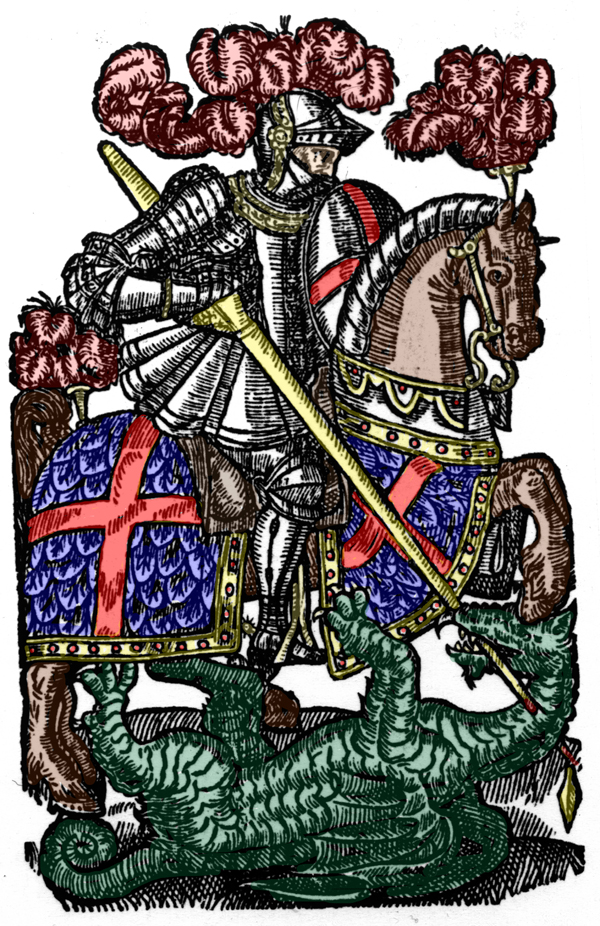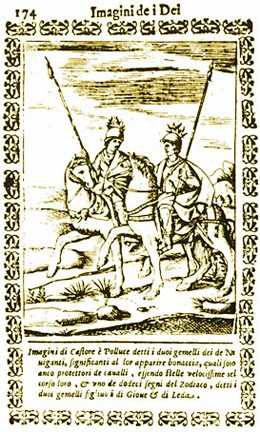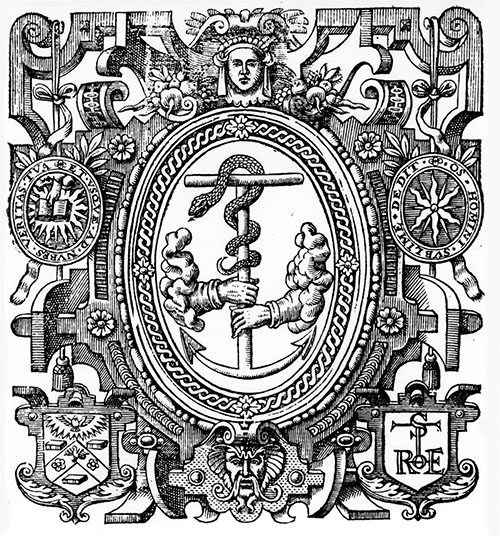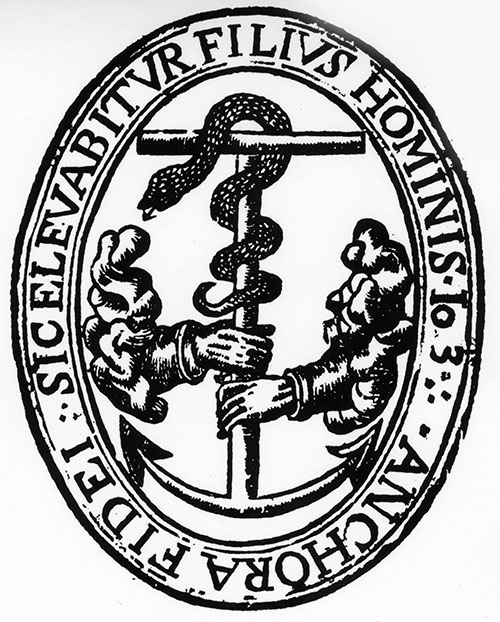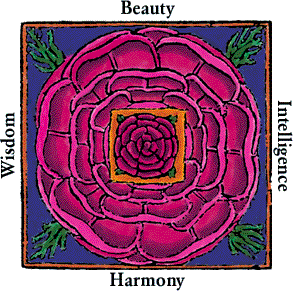St George & the Dragon
“There is in man’s nature, a secret inclination and motion, towards love of others, which if it be not spent upon some one or a few, doth naturally spread itself towards many, and maketh men become humane and charitable; as it is seen sometime in friars. Nuptial love maketh mankind; friendly love perfecteth it; but wanton love corrupteth, and embaseth it.”
Francis Bacon, Essay, Of Love.
St George and the Dragon
Shakespeare is intimately linked with St George, the patron saint of England, in two ways. The first is by the legend that Shakespeare was born on St George’s Day and died on St George’s Day. The second is by the attribute of St George as a Spear-shaker, or Shake-spear, shaking his lance of light against the dragon of ignorance, as declared of the author Shakespeare by Ben Jonson in Jonson’s tributary poem which prefaces the 1623 First Folio of Shakespeare plays.
… … Look how the fathers face
Lives in his issue, even so, the race
Of Shakespeares minde, and manners brightly shines
In his well torned, and true filed lines:
In each of which, he seems to shake a Lance,
As brandish’t at the eyes of ignorance.
Ben Jonson uses the term “eyes” for dragon, as the dragon is symbolic of the human soul, which is an intelligence or ‘mind’ whose ultimate purpose is to see and know the truth by practising it, living it. The eye is another symbol for the intelligence, mind or soul. The eye becomes the All-Seeing Eye, which the Egyptians called the Eye of Horus, when we can see and know all truth. This is known as full illumination.
St George represents the higher immortal self of a human being, the lower mortal self or psyche being the dragon. The Gemini is another story that explains this twinship of the higher self with the lower self, of the immortal with the mortal. Ultimately, they become one in a mystical marriage or union and are known as the immortal-mortals or mortal-immortals, otherwise rendered as the expression “son of man, Son of God”.
The spear represents the ray of wisdom inspired from the higher self into the heart of the lower self. This ray of wisdom is ‘breathed’ into the human being via what is referred to as the ‘alta-major’ or ‘eighth’ chakra. This alta-major chakra is centred in the medulla oblongata but has its etheric opening or ‘mouth’ at the back or nape (nuncha) of the neck. For this reason, this is a particularly sensitive part of the human body. The chakra itself is known as the ‘mouth of God’, as also the ‘Pan chakra’. The name or word ‘Pan’ means ‘All’. The chakra has this name because it links us with universal consciousness. The word ‘All’ is derived from Al (or El), a name of God (hence Allah), who is the All. For this reason, most traditional paintings or sculptures of St George and the dragon show St George’s spear piercing the dragon via its throat or mouth before entering its heart.
In other words, St George’s spear is akin to the spiritual breath that is inspired into the human heart via the ‘mouth of God’, associated with the nape of the neck. It is echoed by the physical or natural breath that is breathed into the lungs via the physical mouth. The spiritual breath comes from behind, the natural breath from the front, whilst the lungs surround the heart, thereby giving us two different ways in which the heaven-earth, spirit-matter polarity expresses itself.
There is also a third way, in which the spiritual energy represented by St George’s spear comes down the spine from above, piercing the human soul from crown to root. In the root is the dragon, asleep in its cave. The spear, which is also a sound, awakens the dragon and causes it to rise up the spine as dragon energy, a subtle energy known in Hinduism as kundalini. When it reaches the crown of the head, enlightenment occurs.
All three ways are symbolised by the serpent (or Jesus) crucified on the cross. The Cross is, in fact, an ancient symbol of light, of wisdom. The spear signifies the vertical axis of the Cross. This is why St George, who shakes his spear at the dragon of ignorance, is also known as the Red Cross Knight, his heraldic emblem being the Red Cross, signifying the Cross of light or wisdom that is, in essence, himself. When portrayed correctly, the crucifixion scene depicts the head of Jesus aligned with the heart of the Cross, thereby giving the hint that the divine wisdom is breathed from the heart of God directly into Jesus via his alta-major chakra or ‘mouth of God’. A further symbolism used in the story of Jesus is that his heart is pieced by a spear.
This crucifixion is a symbol of death but also of enlightenment, because, when we are enlightened, we undergo a death in the sense that our mortal self dies by becoming immortal. We become the immortalised mortal or immortal-mortal, ‘Son of God and son of man’. We have undergone the mystical marriage of heaven and earth, wisdom and intelligence, spirit and soul, bridegroom and bride, St George and the dragon. Hence why, in one of the myths about St George, when he encounters and slays the dragon, he releases the virgin from her captivity in the dragon’s cave (or within the dragon’s belly), rides off with her on his horse and marries her. In other words, the dragon is transformed into a pure soul, who then marries St George, the spirit.
St George is the personification of the archangel Michael, who ‘fights’ the dragon Satan. The Hebrew name, Michael, means ‘One who is like God’ or ‘Countenance/Face of God’. An angel (ang-el) is a divine thought or idea, a holy intelligence. An archangel is a supreme thought of God—a spiritual archetype. Moreover, the archangel Michael is referred to as the leader of all the angelic hosts, because, as his name describes, he is the divine archetype of “man” who is created in the “likeness” of God (Genesis 1:26-27). But he, Michael, has a feminine counterpart, for everything is male-female.
In Genesis chapter 1, the word ‘God’ is used as a translation of the Hebrew word Alahim, which is a plural word and refers to Al-Alah ('Father-Mother'), the All, who made “heaven and earth” (Genesis 1:1). Alahim is now usually spelt Elohim, and Al and Alah are usually rendered El and Elah. In Aramaic they are Abba and Aima. The important thing to note, though, is that God—as known to Moses, the prophets, Jesus, and his disciples—is male-female, and that this is what the 'AA' hieroglyph of the Rosicrucians essentially represents.
This is why “man” (meaning ‘mind’), who is created in the “image” or “likeness” of God (Alahim/Elohim), is created “male-female”, as indeed are all things, as everything has polarity. This is the ‘Double-Truth’, as anciently known. The relationship between the two poles makes the third. If it is a perfect relationship of love, it is a Holy Trinity, with the ‘third’ (the love-relationship) manifesting or expressing itself as the light of love, known as the child or ‘Son/Sun’ (who or which is also male-female). The “man” referred to in Genesis 1:26-27 is the spiritual mind, the higher immortal self.
The dragon Satan, also known as Lucifer, is the feminine counterpart of Michael. Both are male-female, but Lucifer is female is respect of Michael. The name Lucifer means ‘light-bearer’, being a Latin name for the archangel Sandalphon in Hebrew Kabbalah. Whereas Michael radiates the divine wisdom in rays (‘spears’) of light, Lucifer is the intelligence that receives the light and gives it form, hence Lucifer’s name. But, more than this, the full purpose of Lucifer, the intelligence or mind, is to know the wisdom. Lucifer is said to have looked into the heart of God and saw what God had prepared for man, which was to create man lower than all the angels but raise man to become higher than all the angels, the crown jewel of all creation. But this is what Lucifer wanted, and Lucifer’s desire brought it about. As it says in Isaiah 14:12-15: -
How art thou fallen from heaven, O Lucifer, son of the morning! how art thou cut down to the ground, which didst weaken the nations!
For thou hast said in thine heart, I will ascend into heaven, I will exalt my throne above the stars of God: I will sit also upon the mount of the congregation, in the sides of the north:
I will ascend above the heights of the clouds; I will be like the most High.
Yet thou shalt be brought down to hell, to the sides of the pit.
In the beginning Lucifer was ignorant of who he-she was, or that the purpose of man is to know God—to know the wisdom, the truth, by becoming the likeness of truth, the image of God.
The fall of Lucifer into the dark abyss of hell refers to the incarnation of the human soul into a natural body on earth. The darkness also refers to its initial state of ignorance. The casting out of Adam and Eve from the Garden of Eden is another allegory of this ‘fall’. The name Lucifer, meaning ‘light-bearer’, refers to the purpose of the human soul, which is to be a vessel of light, of wisdom, and to know that wisdom. It is symbolised by the grail, which has to become holy (the Holy Grail) and be raised up to the highest heaven, to become the crown jewel of all creation.
The dragon is said to sleep in a cave, walk on land, swim in water, fly in the air, and breathe fire. It is a symbolic figure representing the elemental make-up of mankind and the alchemical process of life, which eventually, with help from St George, becomes the path of initiation and illumination. When the dragon becomes illumined, it becomes the royal dragon. Another myth tells of it becoming transformed into a virgin woman, emblematic of the pure but still mortal human soul, who then rides away with and marries St George, the immortal self. They then, in their unity, become the immortal-mortals.
St George is portrayed as riding a white horse. Like Pegasus, this represents the higher, pure mind or intelligence that thinks good thoughts, wise thoughts, and hence shines with light. (Horses symbolise thoughts. A black horse, for instance, is symbolic of nightmares.)
The name George means ‘Cultivator’, which is the primary description and purpose of Adam and Eve, whose God-given instructions were to be the gardeners of Paradise, and then, after the fall from Paradise, gardeners of nature. The description of ‘cultivator’ makes the meaning of ‘gardener’ more explicit, linking gardening with culture and civilisation: in other words, the culture of nature and the culture of the mind. Ignorance, symbolised by the dragon, is not just a lack of knowledge but a lack of culture. True knowledge develops culture: they go hand in hand. A lack of either is a darkness which often causes hardship and allows vices of various kinds, including greed and cruelty, to propagate voluptuously like weeds or to cause barren deserts and contaminated seas to appear, damaging both humanity and nature. This the dragon represents; but the dragon also signifies the process of ignorance and vice evolving into knowledge and virtue, accomplished by means of the love and wisdom breathed into the dragon by the Spear-Shaker.
The Rose and Cross
The main heraldic emblem of St George is the Red Cross. The colour red, in heraldry, represents the metal gold. In other words, the Red Cross is the Gold Cross, symbolising the radiant light of love.
St George is also associated with the rose. The rose is the emblem of the virgin soul, the transformed dragon, whom St George marries.
St George personifies the Cross of light, the spirit; the dragon transformed into the virgin soul is the rose. Their marriage or union in love and full consciousness is symbolised as the Rosy Cross.
When the historical Society of the Golden and Rosy Cross was formed in England in 1570, these are the symbols they adopted and used as their name. When the supernova appeared in Cassiopeia in 1572, this was the sign for them to begin their work. With Elizabeth I personifying the Virgin (or Faery) Queen, and her knights and ladies gathered around her in a ‘Round Table’, they commenced a cultural programme of education and training in which poetry and pageantry played a large part. St George, the Red Cross knight, was their patron saint; King Arthur, whose heraldic emblem was likewise the Red Cross, was their patron king. They brought about the blossoming of the English Renaissance, a crown jewel of which is the Shakespeare work.
© Peter Dawkins, FBRT
rev. 27/03/2022
